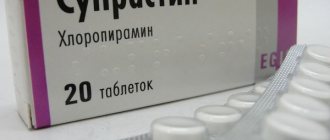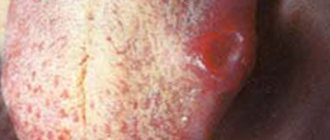Laryngeal edema is a syndrome that occurs for a number of reasons, but it is not an independent pathology. When the mucous membrane swells, the body tries to warn that something is wrong. The tissue most often endangered is the loose submucosal epithelium of the larynx, this is the vestibular fold, the aryepiglottic fold, and sometimes the interfold space, the surface of the epiglottis.
Symptoms of laryngeal edema may be minor; in such cases, the pathology is considered limited or diffuse, when the patient has difficulty breathing due to severe narrowing of the lumen of the throat. Such situations threaten not only the health, but also the life of the patient and require emergency assistance.
Nature of pathology
Swelling of the throat occurs when an inflammatory process develops in the soft tissues of the pharyngeal cavity. The syndrome can signal many diseases, for example, tuberculosis, laryngotracheitis, pharyngitis, influenza, or a burn of the mucous membrane after an X-ray examination, which is carried out in patients with tumor processes in the neck.
Laryngeal edema in a child can develop due to infectious diseases that occur in the acute stage - for example, tonsillitis. If the syndrome occurs outside of inflammation, it may indicate pathologies of the kidneys, liver and heart.
The swelling may also be of an allergic nature. This manifestation should always be taken seriously, without ignoring the symptoms of swelling. If first aid is not provided to the patient in time, he may simply suffocate and die from asphyxia.
The cause of edema is often untreated diseases of the larynx, which are indicated by pronounced symptoms
The inflammatory process can be of several types - edematous, catarrhal, fibrinous-necrotic and infiltrative. Edematous and catarrhal stenosis often occurs against the background of a viral infection or allergy. If therapy is started on time, then the symptoms of allergic laryngeal edema can be easily eliminated and the patient’s life is not in danger.
With fibrinous-necrotic and infiltrative edema, a bacterial infection often occurs. The mucous membranes begin to produce copious amounts of thick and viscous secretion, which further aggravates the situation. Stenosis of this kind can be complicated by the formation of a hemorrhagic cortical layer on the mucous tissue, the appearance of pus and necrotic deposits.
Angina
An infectious disease accompanied by an inflammatory process in the tonsils is called tonsillitis or tonsillitis. If left untreated, the disease can lead to complications in the heart and gastrointestinal tract, so therapy must be approached responsibly.
Symptoms
Characteristic signs of tonsillitis are:
- high temperature (up to 40°C);
- swelling of the larynx;
- redness in the throat;
- feeling of burned skin, body aches;
- joint pain;
- weakness.
If purulent formations appear on the tonsils, it is better to consult a doctor, since treating such a sore throat on your own is very dangerous.
Treatment
Tonsillitis is easy to treat if it is started in a timely manner:
- You can prepare an alcohol tincture of propolis, gargling which will help get rid of symptoms in two days. 15 g of bee glue is finely ground and poured with 50 ml of alcohol. The remedy needs to be infused for two weeks, so it is better to prepare the medicine in advance and always keep it in the first aid kit. A teaspoon of tincture is diluted with 200 ml of water and gargled every two hours.
- Propolis in its pure form has a good anti-inflammatory effect. A small piece of it should be chewed for 15–20 minutes up to four times a day.
- You can cure tonsillitis with cabbage leaf compresses. An old cabbage leaf is applied to the throat and secured overnight with a bandage or gauze.
Causes of swelling
Edema of an inflammatory nature can occur in the following diseases:
- oral diseases;
- laryngeal sore throat;
- laryngitis occurring against a background of suppuration;
- abscess in the epiglottis area;
- suppuration of the tongue.
Inflammatory swelling occurs with pronounced symptoms, while non-inflammatory swelling goes completely unnoticed. The only indicator in such cases is severe discomfort during swallowing food and saliva, accompanied by heavy breathing.
Non-inflammatory edema occurs with the following provoking factors:
- diseases of the cardiovascular system;
- kidney disease;
- liver pathologies, including cirrhosis;
- allergic reactions to irritants - food, animal hair, plant pollen, medications;
- compression of the lymphatic vessels, which leads to impaired blood circulation.
Also, the trigger mechanism for the development of the syndrome can be causes of swelling of the throat, such as mechanical damage, for example, swallowing a foreign object. If a person eats very hot food, this can cause a burn of the mucous membrane and widespread inflammation, and as a result, swelling.
Edema often develops as a consequence of surgical interventions in the larynx
Suppuration of any organ that belongs to the laryngeal region or peripharyngeal space can also provoke the development of severe edema. This also includes purulent-inflammatory processes of the tonsils and the root of the tongue. In most cases, laryngeal edema is accompanied by infectious diseases such as scarlet fever, measles, typhoid, diphtheria, and epiglottitis.
Treatment of laryngeal edema
Since children have the greatest chance of encountering laryngeal stenosis, they are most often given first aid. It is the same for both children and adults. To do this you need:
- Call an ambulance as soon as possible. During the phone call, you need to inform the dispatcher about laryngeal stenosis in the child, because in this case they are obliged to relieve the swelling within the next hour.
- Calm down and try to calm the child, because excitement can increase swelling of the laryngeal tissues.
- Give him anti-allergy medicine. There is a high probability of swelling reduction after taking the drug.
- Increase the humidity level in the room. To do this, you need to turn on the humidifier or use steam.
- Do inhalation with alkaline agents (saline solution or Borjomi water). These substances relieve cough during stenosis.
- Steaming or rubbing your feet is a distracting procedure.
After the ambulance arrives, you need to know that hospitalization must be mandatory, since this condition is extremely life-threatening for the patient.
Allergic edema
Allergic swelling of the larynx is caused by a number of factors to which the human body reacts negatively. This could be certain food products, household chemicals, street or house dust, medicines, and others.
The provoking factor that caused the development of allergic laryngeal edema can be identified during examination of the patient. If the irritant enters the body through the respiratory system, stenosis will affect the area of the larynx and epiglottic cartilage. If the esophagus has become the conductive path, then the swelling is localized among the arytenoid cartilages.
How dangerous the manifestations of stenosis will be depends on whether the airway lumen is severely narrowed. At the first stage, the beginning symptoms of allergic edema are noticeable - it is difficult for the patient to inhale and exhale, the time interval between these phases is significantly reduced, breathing becomes deeper, with elements of shortness of breath, pulse and heart rate decrease. Upon examination, swelling of the tonsils, uvula and soft palate is recorded.
Symptoms of throat diseases
If first aid measures are not taken at the initial stage of allergic stenosis, subsequent symptoms will manifest themselves much more intensely:
- pain when swallowing saliva;
- hoarseness of voice;
- lack of oxygen;
- suffocation;
- feeling as if a foreign object is stuck in the throat;
- barking, rough cough;
- pale skin, which becomes bluish as stenosis progresses;
- sweating and chills, possibly a slight increase in temperature;
- anxiety.
First aid for this type of stenosis should include intravenous administration of Atropine and magnesium sulfate. More qualified assistance will be provided by the arriving medical team, which must be called immediately when symptoms of stenosis appear. However, before the ambulance arrives, it is necessary to limit the patient’s contact with the irritant and try to restore his respiratory function.
Often allergic stenosis of the throat leads to the development of severe swelling, called Quincke's edema.
The allergic form of stenosis is very dangerous, especially in children, since the swelling grows quickly, one might say instantly, and such a condition threatens the health and life of the patient
First aid for allergic stenosis
Every person prone to allergic reactions, as well as his loved ones, should be aware of the urgent measures that need to be taken in case of stenosis. First aid for swelling of the larynx includes, firstly, immediately calling an ambulance.
Secondly, the patient needs to rinse the stomach if there is a suspicion that the throat is swollen after eating any irritating food. After this, it is recommended to give the patient Smecta, activated carbon or another similar drug.
If stenosis occurs as a result of an insect bite, you need to remove the sting from the skin or suck out the poison. The patient should be placed on a hard surface, with his feet above head level. Ice is applied to the victim’s head and neck, clothing is unfastened and cool air is provided into the room.
Antiallergic tablets that can be given to the patient are Tavegil, Suprastin, Zyrtec. The patient is also provided with plenty of fluids; if the condition is satisfactory, a warm foot bath can be taken without any additives. If the condition is critical, then the patient can be given an injection of Dexamethasone or Prednisolone - glucocorticosteroid drugs.
It’s clear what to do before the doctors arrive. Severe manifestations of allergic stenosis should be treated in a hospital, where the patient will be shown the following medications:
- calcium gluconate in the form of a solution for infusion;
- ascorbic acid and glucose intravenously;
- Veroshpiron;
- Furosemide;
- Bumetanide.
If there is no effect of drug therapy, the patient is intubated and then tracheotomy. The throat is cut at the site of swelling, and a cannula is inserted through which the respiratory function is carried out.
How does a doctor provide first aid?
Within the hospital, specific first aid measures, identical in all cases, are carried out.
- It is required to administer adrenaline intramuscularly or intravenously. If the technique does not have an effect, it is necessary to inject the drug into the root of the tongue. It is well vascularized, so the action will be fast.
- Inhalation of oxygen in various concentrations is mandatory.
- Administration of glucose and saline intravenously to normalize the patient's condition. Solutions nourish a weakened body.
- It is also necessary to administer bronchodilators based on fenoterol and ipratropium bromide.
- In the absence of the latter, the use of Prednisolone or Dexamethasone (intramuscular or intravenous) is required.
- First generation antihistamine injections.
- The use of aminophylline is required. It allows you to expand the airways and normalize breathing.
- When asphyxia develops, the soft tissues of the throat and trachea are dissected to form a stoma (tracheostomy). Required in extreme cases. The measure is temporary.
We suggest you familiarize yourself with the appearance of white plaque on the teeth near the gums: how to get rid of hard deposits for a child and an adult? — Health Worker
Stenosis with sore throat
Swelling of the throat with sore throat is the most dangerous complication of the disease. The syndrome appears when the symptoms of tonsillitis are ignored, inadequate treatment and non-compliance with medical recommendations, as well as when bed rest is neglected. The main sign of such edema is swelling of the larynx, which does not spread further. In more severe cases, acute damage to the ligaments and the space underneath occurs.
Infection in the folds of the mucous membrane of the throat leads to difficulty breathing, which develops quite quickly. The patient has an increased heart rate and has difficulty swallowing. The sore throat spreads to the ear area, and the face takes on a bluish tint. Hoarseness occurs against the background of a dry but moderate cough. The patient experiences panic fear for his life, which is manifested by agitation and motor activity.
First aid
A patient in a panic state is incapable of self-control, so he needs to be seated in bed, then given antihistamines, anti-inflammatory and diuretic drugs.
Swelling of the throat with sore throat requires quick and clear actions that can quickly eliminate its symptoms
It is useful to gargle with an antiseptic solution, and then improve oxygen circulation with the help of antihypoxic drugs - vitamin C, Cytochrome C. Often patients are helped by swallowing small pieces of ice - cooling the throat copes with swelling and pain. If the stenosis has receded and the patient has experienced relief, he should be put to bed and taken to the doctor the next morning.
The development of laryngeal edema during angina can lead to the formation of a peritonsillar abscess, therefore, to prevent complications, the patient is recommended to undergo examination. An abscess appears in those tissues where there is a focus of bacterial infection and an accumulation of purulent-necrotic masses.
Symptoms
A syndrome such as laryngeal edema has its own typical manifestations, which are difficult to confuse with others. Symptoms may increase gradually or develop instantly, depending on the form of the pathology.
With acute edema, symptoms arise rapidly and lead to the development of suffocation in a matter of minutes. In subacute and chronic cases, symptoms can develop over several hours or even days, and during this time the body manages to adapt to insufficient oxygen supply, so the symptoms of the pathology are not so pronounced in a child or adult.
The first sign of such a pathological condition as laryngeal edema is a sore throat and a feeling of the presence of a foreign body. The general condition of a child and an adult with this pathology is disturbed - there is weakness, an increase in temperature to high levels, and the appearance of anxiety and irritability.
Breathing becomes difficult, becomes noisy and whistling, a dry cough and shortness of breath appear. There is hoarseness of the voice, up to its complete loss (aphagia).
Eventually, without treatment, the child or adult develops laryngeal stenosis, leading to respiratory failure.
Cold swelling
Laryngeal stenosis often develops with colds and other viral diseases, in particular laryngitis. This disease is not always accompanied by swelling, but patients with an allergic predisposition are prone to this syndrome.
Swelling with laryngitis is often observed in children, since their airways are imperfect and susceptible to various types of inflammation.
Symptoms of cold swelling are typical:
- noisy, heavy breathing;
- barking cough;
- retraction of the sternum and intercostal spaces during inspiration;
- shallow, irregular breathing;
- convulsive syndrome - in severe cases.
Treatment for swelling of the larynx in a child should be carried out in a hospital setting, since this condition threatens his life. Before the ambulance arrives, you need to give the baby a warm drink and also make a hot foot bath. It is prohibited to add any flavorings to the water, as this will aggravate the allergic attack.
It is advisable not to let him fall asleep, but to ask him to sit quietly on the bed. Giving any medications is not recommended because children are too sensitive to medications. How to relieve swelling of the throat with laryngitis is clear; subsequent treatment of pharyngeal edema will be symptomatic and aimed at eliminating the viral or bacterial infection that caused the dangerous syndrome.
Etiological factors
In children, the respiratory muscles are poorly developed and the lumen of the larynx is small, which contributes to the development of its swelling. Even the slightest increase in the mucous membrane narrows the lumen by 2 times. Symptoms of edema in children include redness and deformation of the mucous membrane of the throat, difficulty breathing, barking cough, and hoarse voice. There are infectious and non-infectious causes of airway obstruction.
Infectious causes:
- Viral diseases influenza, acute respiratory infections. The infection occurs when the virus enters the mucous membrane of the throat or eyes. With influenza and acute respiratory infections in children, redness and slight swelling of the larynx are observed.
- Bacterial infections causing tonsillitis, laryngitis, epiglottitis. These diseases are characterized by inflammation of the tonsils and posterior walls of the pharynx. Swelling of the throat makes it difficult for the child to breathe and causes pain when swallowing.
Non-infectious causes:
- Allergic reaction. Swelling occurs when an allergen enters a child’s body through the respiratory tract or skin. The pathogenic agent can be present in food, medicines, and detergents. Along with swelling of the throat, a cough, runny nose, and watery eyes may occur. If allergic edema occurs in a child, it is necessary to urgently call a doctor, as there is a risk of severe suffocation.
- Ingestion of a foreign object. In this situation, attempts must be made to extract it. You need to grab the child from the back by the stomach and make sharp movements from bottom to top, or tilt the baby down and tap between the shoulder blades.
- Laryngeal stenosis is a narrowing of the lumen of the organ, impeding the passage of air through the respiratory tract. The cause of the condition in children may be diphtheria, epiglotitis, or an acute form of laryngotracheitis.
The development of airway edema is divided into 4 stages. At the first stage, the child is able to breathe calmly, there is no threat to life. At the second stage, breathing becomes more difficult, coughing begins, wheezing and shortness of breath are present. At this stage, urgent measures must be taken, otherwise serious consequences will follow. At the third stage, the child’s heartbeat quickens, the pupils dilate, and the skin turns blue due to lack of oxygen. In the fourth stage, asphyxia occurs, the child turns pale and loses his breath. If help is not provided, death is inevitable.
Infectious causes:
- Viral diseases influenza, acute respiratory infections. The infection occurs when the virus enters the mucous membrane of the throat or eyes. With influenza and acute respiratory infections in children, redness and slight swelling of the larynx are observed.
- Bacterial infections causing tonsillitis, laryngitis, epiglottitis. These diseases are characterized by inflammation of the tonsils and posterior walls of the pharynx. Swelling of the throat makes it difficult for the child to breathe and causes pain when swallowing.
Non-infectious causes:
- Allergic reaction. Swelling occurs when an allergen enters a child’s body through the respiratory tract or skin. The pathogenic agent can be present in food, medicines, and detergents. Along with swelling of the throat, a cough, runny nose, and watery eyes may occur. If allergic edema occurs in a child, it is necessary to urgently call a doctor, as there is a risk of severe suffocation.
- Ingestion of a foreign object. In this situation, attempts must be made to extract it. You need to grab the child from the back by the stomach and make sharp movements from bottom to top, or tilt the baby down and tap between the shoulder blades.
- Laryngeal stenosis is a narrowing of the lumen of the organ, impeding the passage of air through the respiratory tract. The cause of the condition in children may be diphtheria, epiglotitis, or an acute form of laryngotracheitis.
The development of airway edema is divided into 4 stages. At the first stage, the child is able to breathe calmly, there is no threat to life. At the second stage, breathing becomes more difficult, coughing begins, wheezing and shortness of breath are present. At this stage, urgent measures must be taken, otherwise serious consequences will follow. At the third stage, the child’s heartbeat quickens, the pupils dilate, and the skin turns blue due to lack of oxygen. In the fourth stage, asphyxia occurs, the child turns pale and loses his breath. If help is not provided, death is inevitable.
Treatment of edema in children is aimed at eliminating the cause of the condition and restoring normal breathing. Antibacterial and antiviral drug therapy is used to treat influenza, acute respiratory infections, sore throat, and laryngitis. Gargles, inhalations and drugs that dilate the bronchi are also prescribed. In case of allergies, swelling must be treated with antihistamines or hormonal drugs. During treatment, the child needs to drink plenty of fluids. Food should be lightly salted, without seasonings, at room temperature. Broths, liquid porridges and soups are recommended. Sweets and allergenic foods should be excluded from the diet: citrus fruits, chocolate, honey. Laryngeal edema in children is a rapidly progressing process leading to oxygen starvation; at the first symptoms of the pathology, you should consult a doctor.
Associated symptoms of throat swelling: what do they indicate?
With swelling of the larynx, additional symptoms may be observed, the presence of which allows one to suspect the underlying cause that caused this phenomenon.
Table 1. Additional appearances and their meaning:
Swelling of the throat in a child is a sign of serious illness. Due to the swollen mucous membrane and narrowing of the lumen of the larynx, the baby’s breathing becomes difficult. The problem often occurs with laryngitis. The main cause of edema in children is the structural features of the respiratory system:
- loose connective tissue underlying the mucosa;
- underdevelopment of the respiratory muscles;
- naturally narrow lumen, prone to edema.
Also, a swollen throat can be observed against the background of oral injuries and a tendency to allergies. Allergic edema is usually associated with the consumption of food irritants. Spices, honey, and fish are dangerous for children's necks.
The infectious nature of edema is explained by viral and bacterial damage to the body of children. Predisposing factors in this case are purulent rashes on the body, sore throat, and diphtheria. Timely treatment of these diseases quickly brings relief and prevents complications, which include swelling of the throat, which can lead to suffocation.
In adults
- plant a person;
- loosen tight clothing;
- put your feet in a basin of hot water or put mustard plasters on the calf muscles;
- put drops into the nose that narrow blood vessels;
- Irrigate the larynx with a solution of adrenaline hydrochloride 0.1%;
- limit drinking;
- let the pieces of ice be swallowed;
- if possible, then give an intramuscular injection of Tavegil, Diphenhydramine.
- Vasoconstrictor nasal drops (drops for runny nose), which contain adrenaline, can completely replace an injection. It is enough to drop 5-6 drops into each half of the nose - and even pronounced Quincke's edema will subside;
- If there are no drops for a runny nose, you can use validol, but also in drops. By the way, it has an excellent local effect on bee stings: 3-4 drops of validol on the sting wound will completely prevent allergic swelling of the limb;
- How to quickly relieve angioedema at home - this question is often asked by those who have family members with allergies. So, the speed of the reaction itself is greatly influenced by the local application of cold. An ice pack will not only reduce the speed of pathological processes, but will also cause additional spasm of skin blood vessels at the site of the bite. If you don't have an ice pack, you can use a sealed plastic bag filled with cold water or soil;
- The common belief that it is better to rub bee stings with damp earth has a certain basis: the earth in the forest is always cool. But, of course, you shouldn’t rub it into the wound;
- For severe swelling of the skin, apply cold compresses;
- Unfortunately, not everyone knows what to do in case of angioedema and what is the first aid for the victim, meanwhile, in the home medicine cabinet you will probably find calcium gluconate tablets that give a fairly good effect;
- Be sure to take antihistamines at the first sign: suprastin, diphenhydramine, pipolfen, diazolin, claretin, etc.);
- When providing assistance for Quincke's edema at home, in the absence of the necessary medications, additional methods are used: gastric lavage, cleansing enema, giving the patient 5-10 tablets of activated carbon, 1 tbsp. l. 5-10% calcium chloride solution (intravenous administration is also acceptable);
- In the process of providing first aid for angioedema, try to establish and exclude the effect of allergens or a non-allergenic causative factor;
- Lubricate the skin generously (especially in areas of contact with the allergen and in the area of edema) with an ointment containing prednisolone or hydrocortisone (sometimes found in first aid kits in the form of eye ointments);
- A good effect is observed from the use of hot foot baths - they promote the flow of blood to the legs and reduce swelling.
- administer dexamethosone at a dose of 0.6 mg/kg or prednisolone at a dose of 5-7 mg/kg up to 30 mg intravenously;
- when providing assistance for laryngeal stenosis in children, it is necessary to perform repeated inhalations (inhalation of an aerosol with corticosteroids (pulmicort, budesonide, hydrocortisone); oral salbutamol 3-8 mg/day during an asthma attack or prophylactically, in the form of an aerosol, 1-2 doses 3-4 once a day or nebulizer inhalation 1.25-2.5 mg during an asthma attack repeatedly; fenoterol inhalation at a dose of 200 mcg, again 100 mcg after 5 minutes or fenoterol - solution for inhalation 1 mg/ml: children < 6 years 50 mcg/kg (10 drops = 0.5 ml), children 6-14 years old - up to 1.0 ml (20 drops), 3-4 times a day; fenoterol 50 mcg ipratropium bromide 20 mcg 1-2 times inhalations 2-3 times a day or fenoterol 0.5 mg/ml ipratropium bromide 0.25 mg/ml solution for inhalation: children < 6 years old up to 50 mcg/kg (up to 10 drops = 0.5 ml) per dose , children 6-12 years old - 10-40 drops per dose 3 times a day);
- epinephrine subcutaneously at a dose of 0.01 mg/kg (not more than 0.3 mg);
- emergency hospitalization in a sitting position;
- if necessary, tracheal intubation;
- It is important to ensure preparedness for cardiopulmonary resuscitation.
- pre-fainting - weakness, dizziness, nausea, discomfort in the heart, in the abdomen;
- fainting itself - partial narrowing of consciousness followed by its loss, decreased muscle tone, paleness of the skin and visible mucous membranes, instability of breathing, pulse, blood pressure; short-term convulsions are possible;
- post-fainting state - rapid recovery of consciousness, there may be residual effects in the form of weakness, nausea, slow heartbeat.
We suggest you read Frequent purulent sore throats in an adult, what to do
Characteristics and reasons
The first group includes the following known and common diseases:
- ARVI, influenza, tonsillitis, laryngitis, pharyngitis, etc. The entry point for infection is the oral mucosa and nasopharynx. Penetration of an infectious agent causes extensive inflammation and swelling.
- Specific inflammations (syphilis, tuberculosis).
The non-inflammatory type group includes:
- Possible mechanical damage (burn of the oral cavity, foreign objects often swallowed by children, postoperative complications).
- Allergies to various foods, seasonal flowering plants, insect bites, dust and odors. This also includes a predisposition to Quincke's edema.
- Edema of the larynx due to diseases of other organs (kidneys, liver, cardiac system).
- Neoplasms in the tissues of the throat mucosa (benign and malignant).
Features of allergic pathology
One of the most dangerous types of non-inflammatory lesions is considered to be angioedema of the larynx. The most common name for the disease is Quincke's edema.
It is characterized by an acute course, which is provoked by various allergens:
- food;
- household (animal hair, dust);
- medicinal;
- fungal;
- pollen.
Quincke's edema develops rapidly and appears a few minutes after contact with the allergen.
After a couple of hours, the lesion develops into an acute form that is life-threatening for the patient. Symptoms of Quincke's edema:
- sudden onset of discomfort, increase in the size of the tongue and lips;
- an increase in primary symptoms: the tongue occupies the entire oral cavity, the tonsils and palate swell;
- with a mild course of the pathology, the attack passes after half an hour;
- Quincke's edema sometimes leads to death.
Swelling of the larynx due to allergies is very dangerous, and therefore requires prompt therapeutic measures. You should urgently call an ambulance. The main method is the administration of antihistamines. It is important to minimize the effect of an allergen that harms human health and life.
Drugs that relieve swelling of the throat
The use of medications for laryngeal edema provides rapid relief of swelling, restoration of breathing and reduction of symptoms of the pathological process.
All medical assistance, taking into account the etiology of laryngeal swelling, is based on taking the following groups of drugs:
- Fast acting diuretics.
- Psychotropic.
- Sedatives.
- Antacids.
- Antihistamines.
Often, when providing care to adults, the following medications can be used:
- Prednisolone – has an antiallergic, antishock, anti-inflammatory effect and has an antitoxic effect. Pharmacological form of release: tablets and ampoules.
- Diphenhydramine - provides blocking of histamine endings, removes spasms of smooth muscles, relieves swelling.
- Furosemide is an emergency diuretic, the use of which is mandatory when eliminating swelling.
- Suprastin, Claritin or Loratadine are antiallergic drugs. By suspending the functional activity of histamine receptors, it removes swelling of the throat, which leads to a decrease in the permeability of the walls of small vessels and eliminates muscle spasms in the throat.
- Fenistil is an antihistamine that has antiserotonin and antibradykinin effects. Helps reduce capillary permeability, which prevents the development of allergies. Has a mild sedative effect.
- No-spa is one of the most effective antispasmodics, the use of which provides relief from spasms of smooth muscles. In combination with other drugs, it relieves pain and prevents suffocation.
Important! The prescription of medications is carried out exclusively by a doctor, taking into account the pathogenesis of throat swelling.
Laryngeal edema: causes and emergency procedures
Knowledge of the mechanism and cause of laryngeal edema will allow you to correctly perform first prehospital aid and possibly save a person’s life.
Various pathological processes can lead to such an emergency condition as laryngeal edema.
When it develops, first aid must be provided immediately, since delay can lead to oxygen starvation, and in severe cases, even death.
Therefore, treatment of this pathology should begin before the doctor arrives. In the future, it is necessary to find out all the possible causes of this condition and try to eliminate them.
Reasons for the development of laryngeal edema
The larynx has a special wall structure, where the submucosal layer is well developed and loosely connected to the mucous membrane. This contributes to the development of an infectious process in this area, resulting in swelling.
Laryngeal edema can have a different nature. The main reasons for this phenomenon will be:
Respiratory tract infection
Damage to the respiratory tract and oral cavity by specific or non-specific bacteria, viruses or fungi, with the development of edematous laryngitis. For example, with diphtheria, measles and scarlet fever.
Allergy
Allergic, or angioedema of the larynx, is an immediate reaction. In addition to the larynx, swelling of the tongue and subcutaneous tissue occurs. The development of such a reaction occurs in response to the action of a specific allergen. These allergens are:
- food products (milk, honey, chocolate, eggs, citrus fruits, strawberries, etc.);
- medicinal substances (penicillins, non-steroidal anti-inflammatory drugs, anesthesia medications, etc.);
- toxins that enter the body through insect bites;
- volatile chemicals that enter unprotected respiratory tracts.
Diseases of internal organs
Advanced or decompensated diabetes mellitus, hypothyroidism. These diseases are characterized by impaired water metabolism and swelling of the tissue. Heart and kidney failure, when swelling occurs as a result of impaired evacuation of fluid from the body.
Traumatic lesions
Damage to the larynx in the form of thermal, chemical burns, mechanical trauma, operations on the neck area. All these mechanisms of damage cause massive release of fluid into the intercellular space, which causes swelling of the larynx and closure of the airway. Damage to the tongue also complicates the course of the disease.
Stages of the disease
Edema of the larynx develops with a certain stage, which can be traced, and at the first manifestations of the disease, the necessary adequate assistance can be provided.
There are the following stages with characteristic symptoms, regardless of the cause of the pathology:
Stage of catarrhal edema and sound production disorders (compensation)
It is characterized by moderately expressed signs of intoxication, a barking cough occurs, and hoarseness appears in the voice. Symptoms of oxygen deficiency are mild. At this stage it is already necessary to begin treatment.
Development of stenosis (narrowing) of the larynx (subcompensation)
The patient is restless because he is unable to take a full breath. Breathing becomes frequent and noisy. The voice is practically inaudible. It can be seen that the person takes a forced position, raising his shoulders as he inhales, and rests his hands on some surface.
Stage of asphyxia (decompensation)
Treatment at this stage should be urgent. The person is restless and tossing around. Can't take a full breath. Symptoms of lack of oxygen are observed: the skin is cold, covered with perspiration, and blueness of the lips and fingertips is observed. The pupils are dilated. Breathing and pulse are frequent.
Laryngeal edema in children
Special attention should be paid to the symptoms and features of the development of laryngeal edema in children. In relation to children, the concept of croup is often used. Croup is a complication of infectious respiratory diseases, expressed by inflammatory swelling of the larynx.
Depending on the cause and spread of inflammation in the tissues of the larynx, false and true croup are distinguished. Their symptoms are similar. True croup occurs only in one disease - diphtheria. This disease affects the submucosal layer of the ligament area.
False croup complicates acute respiratory infections caused by influenza viruses, parainfluenza, respiratory syncytial virus, and adenovirus. The mucous and submucosal membranes are damaged not only in the ligament area, but also in the entire larynx. Inflammation spreads from the palatine tonsils, tonsils of the root of the tongue and other ENT organs.
First aid for laryngeal swelling
First aid should be provided directly at the site of acute symptoms. Swelling of the larynx can be fatal; you must not hesitate; timely first aid can save your life.
You need to call an ambulance immediately. The person needs to be seated and ensure the flow of fresh air. Treatment with cold or hot compresses on the neck area is not permitted.
When exposed to heat, there will be a rush of fluid to the application site, which will provoke increased swelling of the larynx.
At home, first aid should include the following procedures:
- immerse your limbs in warm water - this will at least slightly reduce the flow of fluid to the laryngeal mucosa;
- take a hot bath for up to 10 minutes. Contraindicated for patients with body temperature over 380C;
- take desensitizing medications. Suprastin, Diphenhydramine, Pipolfen, Fenkarol are found in most people's medicine cabinets;
- drink alkaline solutions at room temperature. This will slightly reduce the symptoms of swelling;
- take Lazolvan (Ambroxol).
Emergency care for laryngeal swelling
Treatment at the hospital stage includes measures to restore the patency of the airways. It is necessary to remove the jaw to prevent the tongue from retracting, and insert an air duct into the mouth.
It is important that the patient receives more oxygen. For this, oxygen masks and artificial respiration devices are used.
If the edema has completely closed the lumen of the larynx, then the entry of the air mixture into the respiratory tract can be achieved by tracheal intubation, tracheotomy, or conicotomy.
In parallel with measures to restore air supply to the lungs, intensive care drugs are prescribed:
- Administration of atropine. This will help relieve excess secretion and mucus formation.
- Adrenaline will reduce the permeability of the vascular wall.
- Hormonal treatment stabilizes cell membranes and eliminates inflammation, relieves swelling of the mucosa and submucosa. Prednisolone and its derivatives are prescribed.
- Infusion therapy is established to relieve acidosis (a shift in the acid-base balance to the acidic side).
- Prescribing diuretics (Furosemide, Hypochlorothiazide), since forcing the removal of fluid will reduce tissue swelling.
- Sedative therapy (Seduxen, Relanium).
- Antibacterial treatment is aimed at suppressing the infection and will help relieve the symptoms of intoxication in the body.
If the cause of edema is diphtheria, then specific treatment - anti-diphtheria serum - is immediately prescribed. Treatment should also include bed rest and diet. Limit the consumption of salt, spices, and acidic foods.
httpss://www..com/watch?v=8lw931U1UEA
Source: https://otekam.net/vnezapnie/prichiny-i-pomoshh-pri-oteke-gortani.html
Diagnostic methods
After providing first aid, the doctor examines the patient, listens to complaints, and performs palpation. To clarify the cause of the disease, diagnostics are carried out using laboratory and hardware techniques. The otorhinolaryngologist prescribes:
- general analysis of urine and blood;
- smear to identify pathogenic microorganisms;
- blood test for allergies;
- examination of the larynx using laryngoscopy using special instruments or mirrors, tissue sampling for biopsy;
- radiography;
- bronchoscopy;
- endoscopy;
- checking blood gas composition;
- study of vocal function.
If there are symptoms of laryngeal edema, the patient is prescribed tests to establish a diagnosis. Diagnosis and determination of the course of treatment for laryngeal edema is carried out by an otolaryngologist.
Methods for examining a patient with edema include:
- Diagnosis and determination of the course of treatment for laryngeal edema is carried out by a visual examination by an otolaryngologist
; - indirect laryngoscopy;
- bronchoscopy;
- study of vocal function;
- computed tomography of the mediastinal organs;
- X-ray of the larynx.
To establish the cause of edema, diagnostic measures such as:
- general blood and urine analysis;
- blood test for immunoglobulin;
- culture of contents from the larynx and trachea.
In case of this phenomenon, differential diagnosis is carried out in order to distinguish laryngeal edema from oncological tumors, acute respiratory viral infections, inflammatory processes, and the presence of foreign bodies that block breathing.
Note! If symptoms of laryngeal edema occur, an ultrasound of the thyroid gland, an X-ray examination of the lungs, an MRI and a CT scan of the brain may be required.
Methods for diagnosing a swollen larynx
Diagnosing laryngeal problems is not difficult. The doctor is convinced of the presence of edema during a laryngoscopic examination of children. In special cases, the otolaryngologist gives the small patient referrals for bronchoscopic and x-ray examination.
As for the reasons, identifying them can be difficult. Tumors and foreign bodies may be hidden behind a swollen larynx. If the culprit of the swelling turns out to be an infectious process, the doctor determines its nature and indicates the form of the disease.
The specialist speaks about the edematous form in case of viral infection of the respiratory tract. He assigns the fibrinous-necrotic and infiltrative form to a bacterial infection. In the 2nd and 3rd cases, the narrowed lumen in children is not only swollen, but also filled with purulent mucous secretions.
Most often, preschool children become patients of a pediatric otolaryngologist, since the lumen of their larynx is not yet sufficiently expanded.
How to relieve throat swelling?
Depending on the etiology of throat swelling, there are various methods to alleviate the condition. The insidiousness of this condition lies in the need to provide emergency assistance to save lives.
There are a lot of medications and improvised means, the use of which reduces swelling and inflammation:
| Pathology | Basics of therapy |
| ARVI, cold | Using infusions of sage, yarrow, chamomile, calendula, St. John's wort for gargling. Using inhallipt, cameton, oracept in the form of a spray for mouth irrigation. |
| Angina | Strict bed rest. Gargling with baking soda and table salt, herbal infusions, carrot or beet juice. Spraying the mouth with an antiseptic solution of chlorophyllipt and using it in oil form for rinsing. Taking dissolving pills. |
| Allergy | Swelling is controlled with antihistamines. When an insect bites, apply a tourniquet above the bite and use tablets or injections of diphenhydramine, or suprastin, or prednisolone. Adrenaline hydrochloride is used to irrigate the throat. At the same time, cold wet compresses should be applied to the throat. In extreme cases, artificial ventilation may be necessary. |
| Laryngitis | A characteristic feature of this pathology is the rapid development of swelling of the throat mucosa, requiring immediate first aid before the ambulance arrives. To do this, the patient is seated, the buttons on his clothes are unbuttoned, and warm milk or Borjomi is given to him to drink. The limbs are immersed in a container of hot water, and to relieve swelling, it is recommended to inhale, preferably with baking soda. In the room where the patient is located, it is necessary to increase the air humidity. |
| Pharyngitis | First of all, factors that irritate the mucous membrane of the throat are excluded. The throat is gargled with solutions of baking soda or furatsilin. Chlorophyllipt or ingalipt are used to irrigate the throat. Inhalations are carried out with anti-inflammatory and decongestant herbal decoctions or with alkaline mineral water. It is recommended to take absorbable antimicrobial pills, and, if indicated, antihistamines. |
| Injury | You should try as quickly as possible to get rid of the foreign body in the throat that causes its damage. To do this, you need to stand behind the victim. Having clasped his torso with your arms on both sides, you should press firmly with your fists in the area slightly above the navel. |
| GERD | Taking antacids or flight pump inhibitors (pantoprazole, lamprazole), and also drinking hot milk with soda. Sea buckthorn and rosehip oils will help reduce symptoms. |










